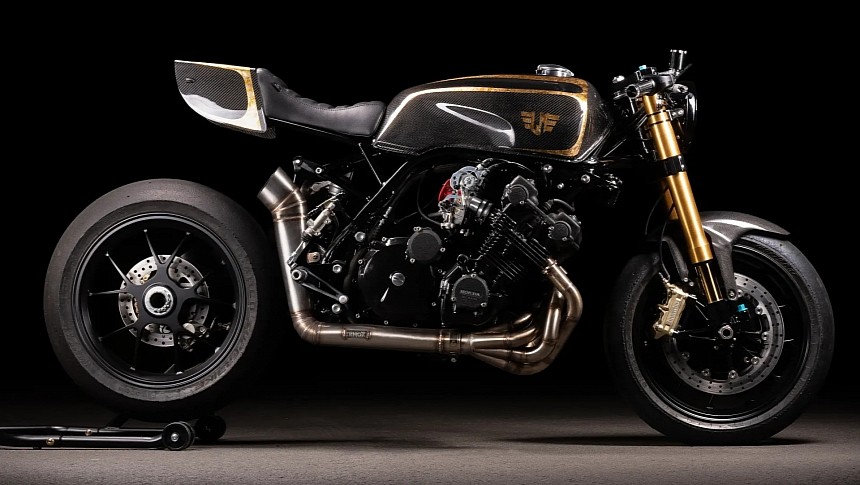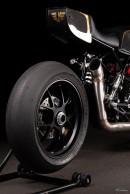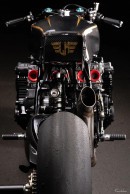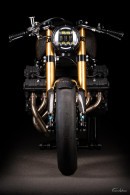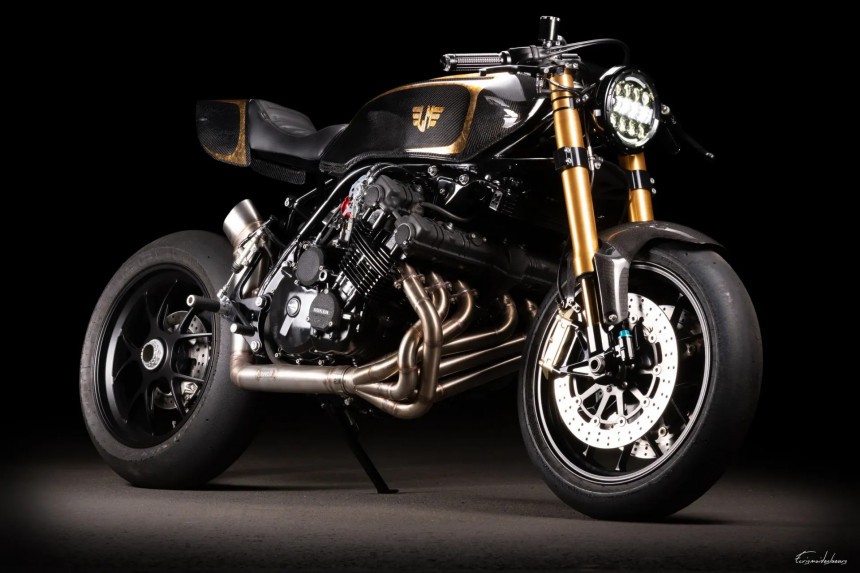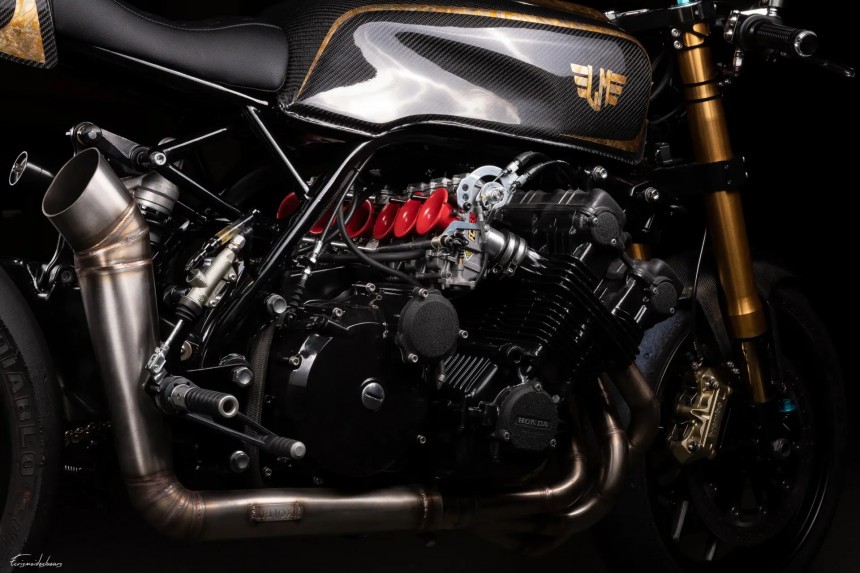The Honda CBX may not have enjoyed the commercial success it deserved while it was in production, but it is nowadays regarded as a true cult classic. One simply cannot deny the allure of its gargantuan six-cylinder powerplant, and don’t even get me started on the majestic exhaust sound it makes at high revs! Heck, many of you might even go as far as saying the CBX is the best-sounding bike ever produced.
A number of factors led to this titan’s demise back in 1982, though underwhelming performance certainly wasn’t one of them. In its earliest iteration, the CBX1000 could extract up to 105 hp from its air-cooled 1,047cc inline-six engine; enough to achieve speeds in excess of 130 mph (209 kph). Power output was reduced to 98 ponies for the model-year 1981, when Honda transformed its beastly flagship into a sport tourer with the aim of boosting sales.
Although the CBX still packed plenty of grunt in its new form, it didn’t quite manage to achieve what the Japanese marque would’ve hoped for. The smaller, four-cylinder CB900F continued to outperform it on the sales charts, so Honda simply couldn’t justify keeping it in production after ‘82. Now, as we’re not here for an extensive history lesson on this nameplate, let’s fast-forward to the present day.
Given its ever-growing status as a collector’s item, there aren’t many people who would extensively customize a CBX in today’s motorcycling world. Dimitri of Lys Motorcycles in France did so on a number of occasions, though, and the results have been absolutely spectacular every time. Built by him in 2020, the specimen shown in these photos was the very first project of this kind.
With Lys Motorcycles becoming a full-time endeavor around 2019, Dimitri needed something of a halo bike to showcase his abilities and be presented at events or gatherings. He set his sights on a 1982 MY CBX as the perfect starting point, with the main goals being to vastly improve its running gear while turning the whole thing into a jaw-dropping cafe racer. Having a clear vision of what had to be done, the Frenchman dug straight in.
Beefing up the chassis was the first thing he needed to do once the donor had been dismantled. At the front, this was achieved by way of modern inverted forks from Ohlins, which are held in place via bespoke triple clamps. There’s no resemblance of the stock componentry lower down, either, as Dimitri ditched all the factory goodies to make way for the Brembo brakes and front wheel of an Aprilia RSV 1000 R.
The custom treatment got even spicier at the back, where suspension is now taken care of by a Ducati 1098’s monoshock and single-sided swingarm. In addition, the Duc also donated its rear wheel and brake, but some clever tweaking was required for these items to fit on the CBX. Both wheels were subsequently enveloped in Pirelli slicks, and the next task on Dimitri’s list had to do with the bodywork.
One might assume the fuel tank is completely new and shaped to resemble the OEM part, yet that would be incorrect. Lys actually kept the standard tank, massaging its southernmost section and wrapping the whole shebang in a layer of carbon fiber for visual effect. There’s a Monza-style filler cap up top, while the motorcycle’s rear end is home to fresh subframe tubing, a black leather saddle from ADC Sellerie, and a CFRP tail.
Dimitri spared no expense when it came to the electrics, completely rewiring the CBX and giving it a lithium-ion battery. Motogadget’s m-Unit control module also makes an appearance, along with a keyless ignition system and premium LED lighting all-round. The controller, starter relay, and battery are stashed within the tail section, while the receiver for the RFID ignition lives inside the seat.
An abundance of Motogadget hardware made its way to the cockpit area, with bits such as bar-end turn signals, stylish grips, and discreet switches adorning a pair of aftermarket clip-ons. The same brand supplied the digital speedometer, which was seamlessly recessed into the top clamp for an ultra-clean look.
We see a top-shelf front brake master cylinder from Brembo, too, and the specimen’s ergonomics are finished off with Tarozzi rearsets. In terms of powertrain upgrades, the massive inline-six motor got treated to an extensive makeover, gaining youthful seals and gaskets in the process. The valve clearances – all 24 of them – have been optimized, and the original carbs were swapped with Keihin FCR 33 alternatives.
These bad boys inhale through red velocity stacks, complemented by a handmade six-into-one exhaust fashioned out of stainless-steel. For the final touches, the machine was garnished with an array of succulent cosmetic details, like gold leaf highlights, a wrinkle paint effect on various engine covers, and four layers of clear coat to make the bodywork shine.
Although the CBX still packed plenty of grunt in its new form, it didn’t quite manage to achieve what the Japanese marque would’ve hoped for. The smaller, four-cylinder CB900F continued to outperform it on the sales charts, so Honda simply couldn’t justify keeping it in production after ‘82. Now, as we’re not here for an extensive history lesson on this nameplate, let’s fast-forward to the present day.
Given its ever-growing status as a collector’s item, there aren’t many people who would extensively customize a CBX in today’s motorcycling world. Dimitri of Lys Motorcycles in France did so on a number of occasions, though, and the results have been absolutely spectacular every time. Built by him in 2020, the specimen shown in these photos was the very first project of this kind.
With Lys Motorcycles becoming a full-time endeavor around 2019, Dimitri needed something of a halo bike to showcase his abilities and be presented at events or gatherings. He set his sights on a 1982 MY CBX as the perfect starting point, with the main goals being to vastly improve its running gear while turning the whole thing into a jaw-dropping cafe racer. Having a clear vision of what had to be done, the Frenchman dug straight in.
The custom treatment got even spicier at the back, where suspension is now taken care of by a Ducati 1098’s monoshock and single-sided swingarm. In addition, the Duc also donated its rear wheel and brake, but some clever tweaking was required for these items to fit on the CBX. Both wheels were subsequently enveloped in Pirelli slicks, and the next task on Dimitri’s list had to do with the bodywork.
One might assume the fuel tank is completely new and shaped to resemble the OEM part, yet that would be incorrect. Lys actually kept the standard tank, massaging its southernmost section and wrapping the whole shebang in a layer of carbon fiber for visual effect. There’s a Monza-style filler cap up top, while the motorcycle’s rear end is home to fresh subframe tubing, a black leather saddle from ADC Sellerie, and a CFRP tail.
An abundance of Motogadget hardware made its way to the cockpit area, with bits such as bar-end turn signals, stylish grips, and discreet switches adorning a pair of aftermarket clip-ons. The same brand supplied the digital speedometer, which was seamlessly recessed into the top clamp for an ultra-clean look.
We see a top-shelf front brake master cylinder from Brembo, too, and the specimen’s ergonomics are finished off with Tarozzi rearsets. In terms of powertrain upgrades, the massive inline-six motor got treated to an extensive makeover, gaining youthful seals and gaskets in the process. The valve clearances – all 24 of them – have been optimized, and the original carbs were swapped with Keihin FCR 33 alternatives.
These bad boys inhale through red velocity stacks, complemented by a handmade six-into-one exhaust fashioned out of stainless-steel. For the final touches, the machine was garnished with an array of succulent cosmetic details, like gold leaf highlights, a wrinkle paint effect on various engine covers, and four layers of clear coat to make the bodywork shine.
